If you are a Dell|EMC customer or follow the enterprise storage market closely, you have probably at least heard of PowerStore by now. Some of our competition has even given it more of a platform by actively talking about it on social media or blogging about it on their sites which is exciting! You know you must be doing something right when that happens! I was skeptical at first, but the more I learn about the product, the more I get excited to speak about it with customers. I get even more excited when I think about the technologies and intellectual property that both Dell and EMC have converged into this next-generation platform. Between Equallogic, Compellent, Unity, VNX, VMAX, and other platforms, there is a lot of good IP that can be architected into a new design. I wanted to start with a basic introduction to the platform, as I’m sure I will do deeper dives in future posts.
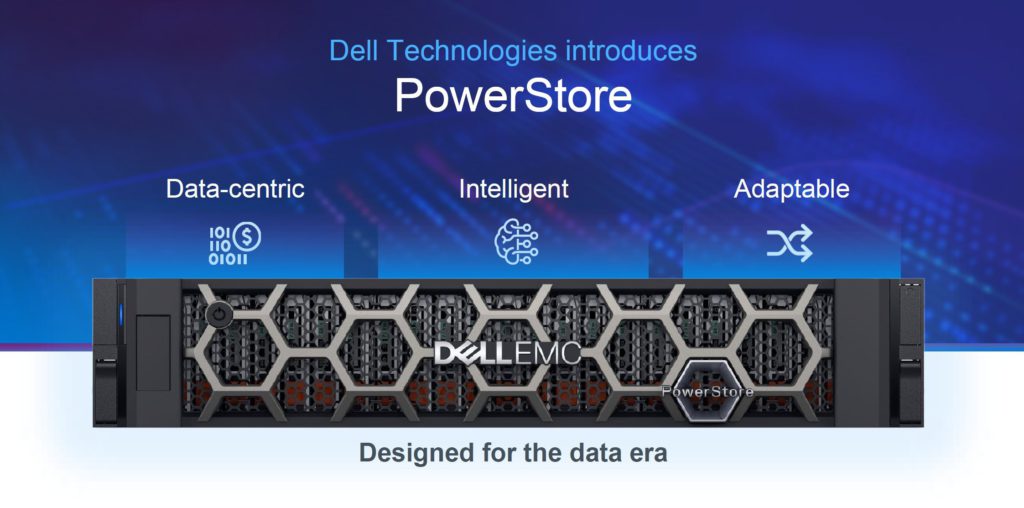
The Basics:
PowerStore is Dell|EMC’s next-generation mid to upper-end enterprise storage platform. It converges intellectual property from multiple products over the years to offer a scalable, flexible, and high performing system into a simple to use storage offering. This, coupled with new exciting programs like “Anytime Upgrades” makes a SAN that is hard to match. First, let us start with the basics of its new architecture. PowerStore is both a scale-up and scale-out architecture. When you purchase an appliance, the system is embedded with two “nodes.” These two nodes are what you would commonly refer to as controllers that are in a dual-active-active state. They are referred to as nodes primarily for two reasons. One is that these are x86 server systems in a chassis with dual Intel Xeon Scalable Processors with a minimum of 192GB of RAM. The second reason is because of its scale-out architecture where multiple appliances can be clustered into one single unit. The idea of being able to scale-out and scale-up allows customers to rest assured that they can scale their systems over time, and not be hindered by constrictive scale-up only architectures that can possibly hit their limitations quickly and be complex to swap out to newer, faster, or higher-end controllers. You could begin your first purchase with a lower-end entry-level model knowing that you can add up to 3 more (4 total appliances max in a cluster) higher-end models in the same cluster.
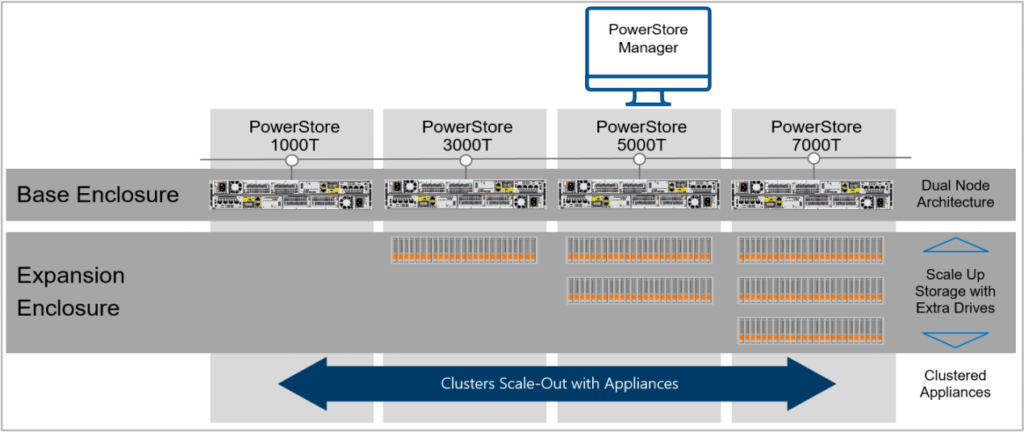
The hardware is even more exciting. Of course, this new offering will have the latest in Intel Xeon chipsets (starting with 8 cores per socket all the way up to 28 cores per socket) and more memory, but the appliance features all NVMe SSD or SCM drives for capacity with 2 or 4 (depending on which model) NVRAM drives for cache. NVMe has been in the peripheral vision of the next generation of the primary storage media, but we are finally at the point where the technology is more affordable than ever. This combined with a new dedupe engine with a 4k block granularity and hardware compression offload drives even more cost efficiency with more effective storage capacity. Dynamic RAID is continued from the Unity XT platform so that expanding a system with additional drives is not limited by legacy RAID algorithms. This allows you to add additional drives of different capacities and not have the smallest drives to be your limiting factor.
| PowerStore 1000T/X | PowerStore 3000T/X | PowerStore 5000T/X | PowerStore 7000T/X | PowerStore 9000T/X | ||
| Intel CPU (Per appliance) | 4 x 8 core @ 1.8 GHz | 4 x 12 core @ 2.1 GHz | 4 x 16 core @ 2.1 GHz | 4 x 20 core @ 2.4 GHz | 4 x 28 core @ 2.1 GHz | |
| Memory (Per appliance) | 384 GB | 768 GB | 1,152 GB | 1,536 GB | 2,560 GB | |
| Max Drives per appliance | 96 | 96 | 96 | 96 | 96 | |
| Max raw capacity per appliance | 898 TB | 898 TB | 898 TB | 898 TB | 898 TB | |
| 4-port card | 25/10/1 GbE optical/SFP+ and Twinax or 10/1 GbE BASE-T | 25/10/1 GbE optical/SFP+ and Twinax or 10/1 GbE BASE-T | 25/10/1 GbE optical/SFP+ and Twinax or 10/1 GbE BASE-T | 25/10/1 GbE optical/SFP+ and Twinax or 10/1 GbE BASE-T | 25/10/1 GbE optical/SFP+ and Twinax or 10/1 GbE BASE-T | |
| I/O modules | 32/16/8 Gb or 16/8/4 Gb FC 25/10/1 GbE optical/SFP+ and Twinax (PowerStore T models only) 10/1 GbE BASE-T (PowerStore T models only) | 32/16/8 Gb or 16/8/4 Gb FC 25/10/1 GbE optical/SFP+ and Twinax (PowerStore T models only) 10/1 GbE BASE-T (PowerStore T models only) | 32/16/8 Gb or 16/8/4 Gb FC 25/10/1 GbE optical/SFP+ and Twinax (PowerStore T models only) 10/1 GbE BASE-T (PowerStore T models only) | 32/16/8 Gb or 16/8/4 Gb FC 25/10/1 GbE optical/SFP+ and Twinax (PowerStore T models only) 10/1 GbE BASE-T (PowerStore T models only) | 32/16/8 Gb or 16/8/4 Gb FC 25/10/1 GbE optical/SFP+ and Twinax (PowerStore T models only) 10/1 GbE BASE-T (PowerStore T models only) |
PowerStore T vs PowerStore X
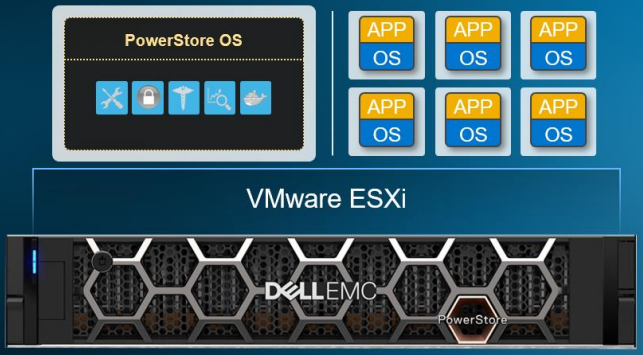
PowerStore has two appliances to choose from. So far, all the features, with some exceptions, are available for both platforms. Now let’s discuss what is different about PowerStore X. Dell|EMC and VMware have a strong partnership being under the Dell Technologies umbrella. With that continuation of partnership and innovation, PowerStore X actually runs ESXi directly on each node. The new containerized Operating Environment, which is PowerStore’s next-generation OS, runs on top of ESXi as a virtual machine. This opens up new doors that I’m sure your mind is already racing about. Out of the gate, we can support vCenter logging the two nodes in your PowerStore X appliance for visibility and management. But we also support virtual machines running directly off of appliance in a feature we call Apps-On. This allows you to run your most storage-intensive workloads directly on the storage system processing the I/O. Currently, PowerStore X does not support clustering as we mentioned previously, but this is a roadmap item.
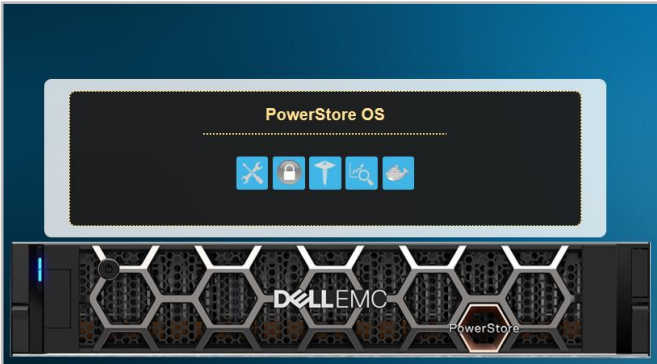
Simple Management with PowerStore Manager
PowerStore manager has been redesigned to bring both consistency and simplicity for day to day management. While “redesigned” and “consistent” don’t seem like they belong in the same sentence, this is achieved through utilizing VMware’s Clarity Design System. This is an open-source set of UX guidelines and HTML/CSS frameworks that lead to a more consistent experience across products. Once you log-in you will immediately start noticing the similarities to other VMware UI’s like vCenter, vROPS, and other VMware tools. PowerStore Manager also integrates analytics for capacity and performance management like you would expect any other modern array to operate. To have even more analytics, PowerStore is designed to work with CloudIQ which is free of chart SaaS tool developed and managed by Dell|EMC to manage your assets.
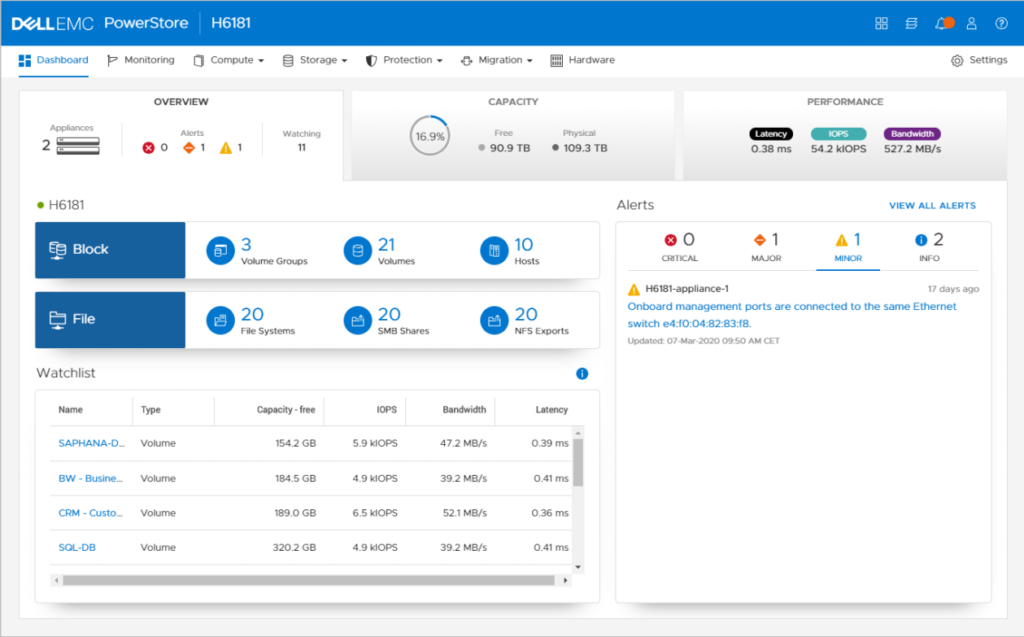
Utilizing an all HTML5 interface, PowerStore Manager lets you manage your volumes, file shares, connected compute nodes, snapshots, hardware, and replication. PowerStore manager is also where you will set up your VMware integration by connecting to your vCenter server. All your host’s information is logged into PowerStore and makes setting up volumes completely automated. It really is amazing how simple block storage is getting to use in a vSphere environment. initiators for iSCSI, for example, are automatically logged in and set up when creating a VMware volume. You can zoom, remove, or add information in your capacity and performance graphs. You also get analytics of items such as how much time you have until you run out of space based on previous utilization. PowerStore is a converged array supporting both block and file workloads. Currently, NFSv3, v4 and 4.1, Secure NFS (Krb5/krb5i/krb5p), SMB 1-3.1, FTP/SFTP, and Three-way NDMP are all supported.
Anytime Upgrades!
The last topic I want to touch on is the new Anytime Upgrade program. This is a feature we introduced with PowerStore to meet the increasing demand to build futures and longevity into your purchase. There have been other programs that bake new versions of a hardware product into your maintenance renewal. While we know that customers do like the idea of extending their platform and adding longevity, we wanted to create a more dynamic and flexible optional program that customers could get the best of both worlds. Anytime Upgrades allow customers to purchase a PowerStore system with an Anytime Upgrade package in one of the following three options:
- Next-Gen: Upgrade appliance nodes to the next generation equivalent models
- Higher Model: Upgrade to more powerful nodes within the current generation
- Scale-Out: Apply a discount to expand your environment with a second appliance equal to the current model
The best part of this program is that it is a one time purchase with a three-year support contract.
Wrap Up!
The next generation of storage is here. It is truly amazing how much we can accomplish with all of the technologies that are available to us today. The availability and affordability of NVMe Storage Class Memory and SSD’s, the flexibility of virtualization, and the speed of the latest processors allow us to create platforms that we never could create in the past. What is available now in PowerStore is very impressive, but I’m even more excited about what we can do in the future, especially when it comes to PowerStore X!